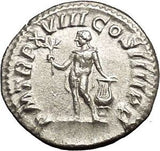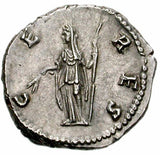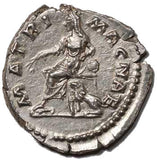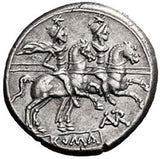In this first article, we aim to discover the mythology of Ancient Rome based on its coins, authentic pieces that faithfully reflect the era. The Romans had a very different way of defining and conceiving the gods than the ancient Greeks, and it is through their coins that we can understand how the various emperors and empresses honored their gods.
 |
APOLLO: Son of Jupiter and Latona, he is the Greek Phoebus; he was the god of music and the arts in general. In ancient Roman coins, he is depicted as a naked and beautiful young man with a lyre and sometimes with a branch. The first Roman emperor, Augustus, dedicated a temple to him in 28 BC on the Palatine Hill to show that he too was spreading his civilization throughout the world. Silver denarius minted in Rome by Caracalla in 215 AD |
 |
BACCHUS: Son of Jupiter and Semele, equivalent to Dionysus of the Greeks. God of harvests and wine, he is usually depicted as a young man crowned with ivy and holding a cup and a bunch of grapes; he is sometimes accompanied by a panther. Bacchus had his own festivities in which he was worshipped, called Bacchanalia, and, as one would expect, wine flowed freely. These festivities are believed to have inspired today's carnivals. Aureo (gold coin) minted by Septimius Severus in 194 AD, depicting the god Bacchus alongside Hercules. |
 |
CERES: Daughter of Cronus and Cybele, she is the goddess of agriculture; she corresponds to the Greek Demeter. One day, while Proserpina was out walking and picking flowers, her uncle Hades kidnapped her. Ceres was so upset by her daughter's disappearance that she neglected the earth and all the plants withered. Winter arrived, which was nothing more than the annual manifestation of Ceres' grief at the loss of her daughter. She is represented as a veiled woman or with a crown of ears of corn and a cornucopia, plow, or ears of corn in her hand. A magnificent and very well-preserved piece minted by Empress Faustina I in 141 AD.
|
 |
CIBELES: Wife of Saturn, also called Rhea. She is the personification of fertile earth, a goddess of mountains and caves, fortresses and walls, nature and animals (especially lions). She is depicted seated on a throne or in a chariot pulled by lions. She sometimes wears a towered crown. Silver denarius minted between 191 and 211 AD by Julia Domna, wife of Septimius Severus. |
 |
DIANA: Daughter of Jupiter and Latona, twin sister of Apollo and goddess of the hunt. She is the Greek Artemis. Having witnessed her mother's suffering during childbirth, she developed an aversion to marriage and therefore asked and obtained from her father the grace of perpetual virginity. A cruel, severe, and vengeful goddess. She had no mercy on any of her enemies: she did not hesitate to destroy their crops, devastate their herds, spread epidemics around them, humiliate them, and even kill their children. Coin minted in 48 BC by the Hostilia family during the Roman Republic. |
 |
DIOSCURI: Castor and Pollux, sons of Jupiter and Leda. Unlike Castor, Pollux possessed the gift of immortality. When Castor died, since they were inseparable, Pollux rejected his immortality so as not to be separated from his brother. They are depicted as children or young men holding horses, usually with stars above their heads. Coin minted and widely used during the Roman Republic. |
We currently have a small number of collections related to the Gods of the Roman Empire. This is an exclusive and very limited collection of 6 silver coins. Each piece has been carefully selected and encapsulated for proper preservation. We have also been able to create two smaller collections related to the Gods. Roman Empire Gods of Virtue Collection, consisting of 3 denarii; and finally, the Collection of Gods of War, also consisting of 3 silver denarii.







